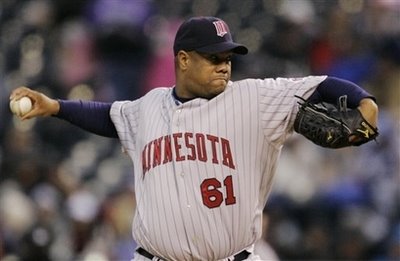April 15, 2008
Is Livan Hernandez the New Ramon Ortiz?
 To examine whether or not Hernandez is destined for that same fate, let's take a little deeper look at the numbers. His strikeout rate has steadily declined for years and his fastball velocity has diminished to the point that MLB.com's pitch-tracking system now identifies many of them as "changeups." Seriously. Because of that it's not surprising to see Hernandez's strikeout rate reach a new low this season with a measly six strikeouts in 21 innings.
To examine whether or not Hernandez is destined for that same fate, let's take a little deeper look at the numbers. His strikeout rate has steadily declined for years and his fastball velocity has diminished to the point that MLB.com's pitch-tracking system now identifies many of them as "changeups." Seriously. Because of that it's not surprising to see Hernandez's strikeout rate reach a new low this season with a measly six strikeouts in 21 innings.
Strikeouts are crucial for pitchers because history has consistently shown that it's difficult to experience long-term success without missing bats. In the short term Hernandez has found success in part because the defense behind him has converted 72 percent of his balls in play into outs, which is a rate that's unlikely to continue all season given that the MLB-wide average is 70 percent, only a handful of pitchers per league tend to get into the 72-percent range each year, and his career rate is 69 percent.
Hernandez's .263 opponent's batting average figures to rise and take his ERA along for the ride unless he begins missing more bats, because he's been fortunate on balls in play. However, he hasn't been nearly as fortunate as Ortiz was last April, when he saw 78 percent of his balls in play turned into outs. No amount of luck or skill makes sustaining that sort of rate likely, and sure enough from May 1 to the end of the season Ortiz got outs only 65 percent of his balls in play while posting a 6.91 ERA.
Of course, strikeouts are merely one piece of a three-slice pitching pie that also includes walks and homers, and Hernandez has thrived in both of those areas thus far. Prior to this season Hernandez handed out 3.1 walks per nine innings during his career, including 3.4 free passes per nine innings last season. That qualifies as poor control, particularly when it comes with just 3.9 strikeouts per nine innings like Hernandez had in 2007.
So far this season Hernandez has walked just one of the 82 batters he's faced, which suggests that he's quickly bought into pitching coach Rick Anderson's mantra of pounding the strike zone. Along with vastly improved control, Hernandez has also been a ground-ball pitcher through three starts after years of inducing mostly fly balls. During the previous three seasons around 38 percent of his balls in play were on the ground, but so far this year that number has risen to 51.4 percent.
Throwing strikes, missing bats, and inducing ground balls is the perfect combination for a pitcher, so it's not surprising to see Hernandez experience success while thriving at two of those three things. His 2.57 ERA won't last long, because even with the big improvements his Expected Fielding Independent Pitching (xFIP) shows him at 4.07, but that still represents a massive step up from the 5.62 xFIP that he posted last season or the 5.40 xFIP that he had in 2006.
Ortiz's strong April was due to unsustainably good luck that even stretched beyond ball-in-play rates, whereas Hernandez's strong start is due partly to luck and partly to sizable improvements in two of the three most important pitching skills. It was only a matter of time before Ortiz unraveled, but Hernandez's case is much more complicated. His sub-3.00 ERA won't be around for long, but posting something in the 4.00s is doable if he can continue to throw strikes and keep the ball on the ground.
His track record suggests that's going to very difficult for Hernandez to keep up. Plus, even if he can miraculously turn himself into a ground-ball pitcher Hernandez will eventually serve up some homers, because around 12 percent of fly balls typically travel over fences and he's been right around that rate for each of the past four seasons before keeping everything in the ballpark so far this year. With that said, unlike Ortiz there's at least a chance that his improved ERA is matched by improved pitching.
Once you're done here, check out my latest "Daily Dose" column over at Rotoworld.

